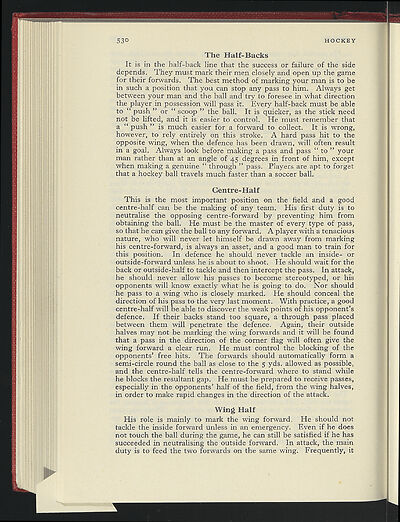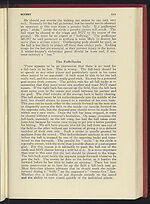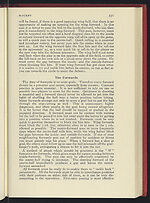1957-58
(550)
Download files
Complete book:
Individual page:
Thumbnail gallery: Grid view | List view

--V"
53
0
HOCKEY
The Half-Backs
It is in the half-back line that the success or failure of the side
depends. They must mark their men closely and open up the game
for their forwards. The best method of marking your man is to be
in such a position that you can stop any pass to him. Always get
between your man and the ball and try to foresee in what direction
the player in possession will pass it. Every half-back must be able
to " push " or " scoop " the ball. It is quicker, as the stick need
not be lifted, and it is easier to control. He must remember that
a " push " is much easier for a forward to collect. It is wrong,
however, to rely entirely on this stroke. A hard pass hit to the
opposite wing, when the defence has been drawn, will often result
in a goal. Always look before making a pass and pass " to " your
man rather than at an angle of 45 degrees in front of him, except
when making a genuine " through " pass. Players are apt to forget
that a hockey ball travels much faster than a soccer ball.
Centre-Half
This is the most important position on the field and a good
centre-half can be the making of any team. His first duty is to
neutralise the opposing centre-forward by preventing him from
obtaining the ball. He must be the master of every type of pass,
so that he can give the ball to any forward. A player with a tenacious
nature, who will never let himself be drawn away from marking
his centre-forward, is always an asset, and a good man to train for
this position. In defence he should never tackle an inside- or
outside-forward unless he is about to shoot. He should wait for the
back or outside-half to tackle and then intercept the pass. In attack,
he should never allow his passes to become stereotyped, or his
opponents will know exactly what he is going to do. Nor should
'he pass to a wing who is closely marked. He should conceal the
direction of his ppass to the very last moment. With practice, a good
centre-half will be able to discover the weak points of his opponent's
defence. If their backs stand too square, a through pass placed
between them will penetrate the defence. Again, their outside
halves may not be marking the wing, forwards and it will be found
that a pass in the direction of the corner flag will often give the
wing forward a clear run. He must control the blocking of the
opponents' free hits. The forwards should automatically form a
semi-circle round the ball as close to the 5 yds. allowed as possible,
and the centre-half tells the centre-forward where to stand while
he blocks the resultant gap. He must be prepared to receive passes,
especially in the opponents' half of the field, from the wing halves,
in order to make rapid changes in the direction of the attack.
Wing Half
His role is mainly to mark the wing forward. He should not
tackle the inside forward unless in an emergency. Even if he does
not touch the ball during the game, he can still be satisfied if he has
succeeded in neutralising the outside forward. In attack, the main
duty is to feed the two forwards on the same wing. Frequently, it
53
0
HOCKEY
The Half-Backs
It is in the half-back line that the success or failure of the side
depends. They must mark their men closely and open up the game
for their forwards. The best method of marking your man is to be
in such a position that you can stop any pass to him. Always get
between your man and the ball and try to foresee in what direction
the player in possession will pass it. Every half-back must be able
to " push " or " scoop " the ball. It is quicker, as the stick need
not be lifted, and it is easier to control. He must remember that
a " push " is much easier for a forward to collect. It is wrong,
however, to rely entirely on this stroke. A hard pass hit to the
opposite wing, when the defence has been drawn, will often result
in a goal. Always look before making a pass and pass " to " your
man rather than at an angle of 45 degrees in front of him, except
when making a genuine " through " pass. Players are apt to forget
that a hockey ball travels much faster than a soccer ball.
Centre-Half
This is the most important position on the field and a good
centre-half can be the making of any team. His first duty is to
neutralise the opposing centre-forward by preventing him from
obtaining the ball. He must be the master of every type of pass,
so that he can give the ball to any forward. A player with a tenacious
nature, who will never let himself be drawn away from marking
his centre-forward, is always an asset, and a good man to train for
this position. In defence he should never tackle an inside- or
outside-forward unless he is about to shoot. He should wait for the
back or outside-half to tackle and then intercept the pass. In attack,
he should never allow his passes to become stereotyped, or his
opponents will know exactly what he is going to do. Nor should
'he pass to a wing who is closely marked. He should conceal the
direction of his ppass to the very last moment. With practice, a good
centre-half will be able to discover the weak points of his opponent's
defence. If their backs stand too square, a through pass placed
between them will penetrate the defence. Again, their outside
halves may not be marking the wing, forwards and it will be found
that a pass in the direction of the corner flag will often give the
wing forward a clear run. He must control the blocking of the
opponents' free hits. The forwards should automatically form a
semi-circle round the ball as close to the 5 yds. allowed as possible,
and the centre-half tells the centre-forward where to stand while
he blocks the resultant gap. He must be prepared to receive passes,
especially in the opponents' half of the field, from the wing halves,
in order to make rapid changes in the direction of the attack.
Wing Half
His role is mainly to mark the wing forward. He should not
tackle the inside forward unless in an emergency. Even if he does
not touch the ball during the game, he can still be satisfied if he has
succeeded in neutralising the outside forward. In attack, the main
duty is to feed the two forwards on the same wing. Frequently, it
Set display mode to:
![]() Universal Viewer |
Universal Viewer | ![]() Mirador |
Large image | Transcription
Mirador |
Large image | Transcription
| Games and sports in the army > 1957-58 > (550) |
|---|
| Permanent URL | https://digital.nls.uk/248858150 |
|---|
| Description | 'Games and Sports in the Army' was an annual publication produced by the British War Office between the 1930s and 1960s. This included the Second World War. It outlines the rules and regulations for games and sports played by members of the armed forces. It features names and photographs of team members, and examples of contemporary advertising. |
|---|---|
| Shelfmark | GWB.52 |

